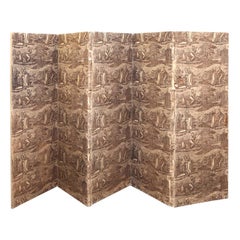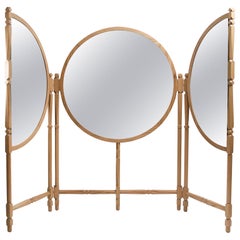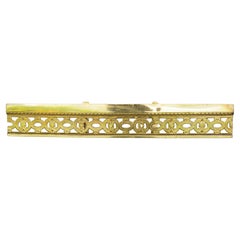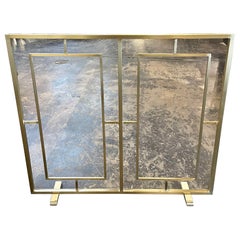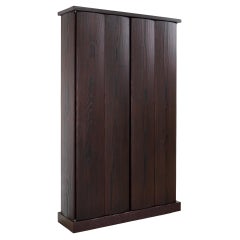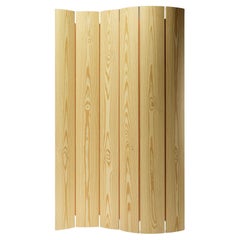Screens and Room Dividers
1850s French Antique Screens and Room Dividers
Upholstery
21st Century and Contemporary Mexican Modern Screens and Room Dividers
Mirror, Oak
19th Century Unknown Antique Screens and Room Dividers
Bronze
2010s Screens and Room Dividers
Brass
2010s Belgian Screens and Room Dividers
Pine
2010s Belgian Screens and Room Dividers
Pine
21st Century and Contemporary North American Screens and Room Dividers
Stainless Steel
1940s French Mid-Century Modern Vintage Screens and Room Dividers
Glass
21st Century and Contemporary North American Screens and Room Dividers
Stainless Steel
20th Century American Hollywood Regency Screens and Room Dividers
Metal
21st Century and Contemporary Dutch Modern Screens and Room Dividers
Cane, Oak, Natural Fiber, Rattan
1950s Finnish Organic Modern Vintage Screens and Room Dividers
Brass
1820s French Empire Antique Screens and Room Dividers
Brass, Steel
1890s French International Style Antique Screens and Room Dividers
Canvas
1920s Asian Vintage Screens and Room Dividers
Wood
Mid-19th Century French Louis Philippe Antique Screens and Room Dividers
Ironstone
1920s Dutch Art Deco Vintage Screens and Room Dividers
Wood
20th Century Unknown Screens and Room Dividers
Oak
Early 1900s European Edwardian Antique Screens and Room Dividers
Leather, Pine
1840s Antique Screens and Room Dividers
Lacquer
Early 20th Century Screens and Room Dividers
Silk
2010s Portuguese Screens and Room Dividers
Brass
1990s Swedish Modern Screens and Room Dividers
Fabric
1890s French Louis XVI Antique Screens and Room Dividers
Wood
2010s Italian Post-Modern Screens and Room Dividers
Other
1970s Mid-Century Modern Vintage Screens and Room Dividers
Plastic, Beech
2010s Italian Modern Screens and Room Dividers
Steel
Mid-19th Century French Napoleon III Antique Screens and Room Dividers
Bronze
17th Century Japanese Edo Antique Screens and Room Dividers
Paint, Paper
1970s Spanish Mid-Century Modern Vintage Screens and Room Dividers
Bamboo
Mid-20th Century Danish Mid-Century Modern Screens and Room Dividers
Teak
Mid-20th Century Mid-Century Modern Screens and Room Dividers
Teak
Mid-20th Century German Modern Screens and Room Dividers
Canvas, Plywood
2010s Belgian Modern Screens and Room Dividers
Marble, Metal
21st Century and Contemporary American Modern Screens and Room Dividers
Wood
2010s American Art Deco Screens and Room Dividers
Straw
2010s American Screens and Room Dividers
Concrete, Cement, Steel
2010s North American Screens and Room Dividers
Bronze, Stainless Steel
2010s American Screens and Room Dividers
Bronze
1950s Mexican Mid-Century Modern Vintage Screens and Room Dividers
Brass
Vintage Screens and Antique Room Dividers on 1stDibs: Japanese Screens, Chinese Screens and Art Deco Screens for Sale
Whether they are implemented as decorative accents or makeshift partitions to ensure privacy, antique and vintage folding screens and room dividers easily introduce sophistication and depth to any space in your home.
The earliest examples of folding screens are said to have originated in China and go back at least as far as the Han dynasty. Screens of the era were heavy structures made of wood and had hinges of cloth or leather. They were adorned with elaborate landscape paintings that were typically created on silk or paper canvases and applied directly to the screen’s panels afterward. Just as they had been in the 20th century and today, the folding screens then were recognized for both their practical and purely decorative properties.
Japanese room-divider screens were also decorated with paintings but constructed to be lightweight and mobile. They took on considerable event-based importance when the structures gained popularity in the East Asian country, as the folding screens were used in performing arts such as concerts, tea ceremonies and more. Later, artists elsewhere warmed to folding screens and sought to create their own.
In European countries such as France, where they were known as paravent, folding screens began to materialize in apartments in Paris, gaining favor with the likes of pioneering couturier Gabrielle “Coco” Chanel, who is said to have accrued more than 30 and used them as a precursor to what we now know as wallpaper.
On 1stDibs, find a wide range of antique and vintage folding screens and room dividers, which, given their history, may do a better job of bringing people and cultures together in your home than sectioning off a space. Search by material to find options in metal, fabric or wood, or browse by style for mid-century modern designs and examples from the Art Deco era.
